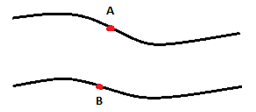This set of Class 11 Physics Chapter 10 Multiple Choice Questions & Answers (MCQs) focuses on “Fluids Mechanical Properties – Streamline Flow”.
1. Velocity has to be the same at the same horizontal level in case of steady laminar flow.
a) True
b) False
View Answer
Explanation: Velocity can be different at the same horizontal level if the area of the cross section at the two points is different. This is according to the equation of continuity, A1v1 = A2v2, where A is area and v is velocity.
2. Consider two points, A & B, on two different streamlines. Bernoulli Theorem can be applied between points A & B.

a) True
b) False
View Answer
Explanation: Bernoulli theorem can be applied only when flow is considered to be steady, non-viscous and most importantly it cannot be applied along two different streamlines. So, the answer for the above question is false.
3. Choose the correct option regarding a streamline.
a) Speed, not velocity, at all points of a streamline is same
b) Two streamlines can intersect in case of laminar flow
c) There is no friction between streamlines in case of steady flow
d) In a given streamline, velocity of a point can vary with time
View Answer
Explanation: If we consider a streamline in a pipe of varying diameter we can say that speed of different points in that streamline are different. The tangent to a streamline gives the direction of velocity at that point, so two streamlines cannot intersect as at the point of intersection we will not be able to draw a single tangent. In case of steady flow across a pipe, there could be streamlines next to each other having different velocities and hence there will be friction between the streamlines which we call viscosity. If flow is unsteady, but not turbulent, the velocity of a point in a streamline can change. For eg: If we slowly increase the speed of a tap flow will be laminar and speed of a point (on a streamline) will increase with time.
4. On which of these following options is the continuity equation based?
a) Work energy theorem
b) Law of conservation of energy
c) Conservation of mass
d) Conservation of momentum
View Answer
Explanation: The continuity equation is based on the conservation of mass. We consider that fluid is incompressible (constant density) and say that mass of fluid passing through 2 different regions at the same time is the same.
∴ density X Vol1 = density X Vol2.
∴ Vol1 = Vol2.
∴ A1v1Δt = A2v2Δt
∴ A1v1 = A2v2.
5. In which one of the following cases can the equation of continuity be used?
a) Compressible flow
b) Incompressible flow
c) Turbulent flow
d) Viscous flow
View Answer
Explanation: For using the continuity equation we assume that the flow is incompressible, laminar and non-viscous. The option that says compressible flow implies that fluid’s density can be changed. So it’s incorrect. The option that says turbulent flow is incorrect as we have to assume flow to be laminar for the equation of continuity to hold. The option that says viscous flow is also incorrect because we assume flow to be frictionless for the equation of continuity to hold.
6. Streamlines of steady flows can be curved.
a) True
b) False
View Answer
Explanation: A streamline is a curve to which tangent at every point gives the velocity of that point. The flow of water through a bent pipe can be steady, and when we observe a streamline in it, it will be curved.
7. A tube of uniform cross section always has water flowing through it. It is kept vertical in such a way that water enters from top and leaves from the bottom. If the speed at a point A below the opening is ‘v’, what will be the speed at a point B vertically below A such that the distance between A & B is ‘2h’?
a) v
b) \(\sqrt{v^2 + 4gh}\)
c) \(\sqrt{v^2 + 2gh}\)
d) v/2
View Answer
Explanation: According to the equation of continuity, the velocity at B will be the same as that at A since the area of the cross section is the same at both points. You may be confused by thinking that gravity will increase its velocity but the pressure will also decrease downwards and therefore net effect will be zero change in velocity.
Sanfoundry Global Education & Learning Series – Physics – Class 11.
To practice all chapters and topics of class 11 Physics, here is complete set of 1000+ Multiple Choice Questions and Answers.
If you find a mistake in question / option / answer, kindly take a screenshot and email to [email protected]
- Practice Class 11 - Mathematics MCQs
- Practice Class 12 - Physics MCQs
- Practice Class 11 - Chemistry MCQs
- Check Class 11 - Physics Books
- Practice Class 11 - Biology MCQs
